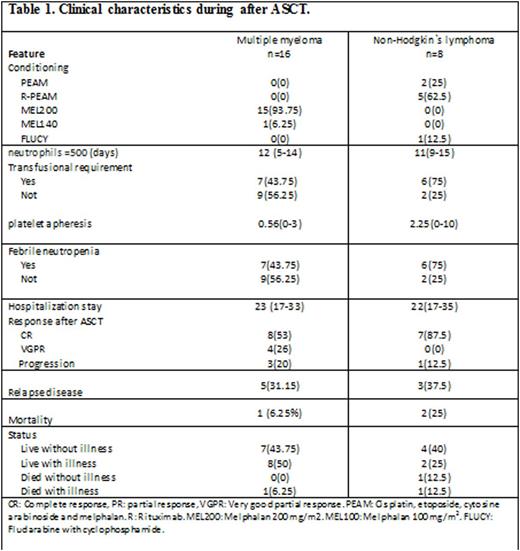Abstract
Introduction
Autologous hematopoietic stem cell transplantation (ASCT) is a treatment option for long-term remission in patients with multiple myeloma and recurrent non-Hodgkin´s lymphoma (NHL).
The eligibility for ASCT is based on a risk-benefit assesssment of the disease, age has not been considered an exclusion criteria for ASCT where treatment related mortality are relatively low. The treatment-related morbidity is associated with toxicity of condition regimen and infections associated with the degree of immune deficiency. Outcome in elderly patients with multiple myeloma and recurrence of Hodgkin´s lymphomas with chemosensitive illness in ≥ 60 years patients undergo ASCT are limited and contradictory. For this reason the aims of the present study was to reviewed to identify patient with multiple myeloma and non-Hodgkin lymphoma undergoing ASCT at 60 or greater and describe the clinical data and outcome.
Method:
This work was a retrospective transversal study, 24 patients older than 60 years was enrolled and all of them were undergo ASCT al Instituto Nacional de Cancerologia, Mexico from 2005 to 2015.
We assessed previous comorbidities, treatment lines, response prior to transplantation, treatment response, relapse free-survived and global survival, it was considered from the transplantation day until last visit at the hospital.
Results
Twenty-four patients were assessed, all were ≥60 years at the transplant moment. 16 of them had diagnostic of multiple myeloma and 8 with Non-Hodgkin's lymphoma (NHL). For the multiple myeloma group the median of age was 66 years (60-70 years), the 81% was male. At the transplant moment, two people in that group had hypertension, one had diagnosis of Diabetes Mellitus Diabetes II and the another did not have any other illness. At the transplant moment 62.5% of the patients had been treated with only one line treatment and 37.5% had been received two treatment lines. On the other hand, at the transplant moment 50% of the patients had completed response, 12% had partial response, 31.26% had very good partial responses and 6.25% had illness progression.
Multiple myeloma patient was conditioned with melphalan 200mg/m2 in 95%. Neutrophils recovery was at 12 days. Fourty-three percent of the patient required transfusion. Neutropenic fever was presented in 43% of the patient. Fifty percent got completed response after ASCT and 20% with progression disease. Relapse disease was in 31% and mortality was 6.25%, there was not mortality associated with the process and 44% is alive without illness (Table 1). In patients with multiple myeloma the OS at two year was 100% and at three years 86%; for NHL patients OS at one year was 67% and at two years 33%. .
For the NHL group the median of age was 67 years (61-72 years), the 50% was male, one person in that group had HTA at transplant moment, another one had diagnosis of MDII, another one had rheumatology disease and another one had long disease, and the other four did not have any other diseases. At the transplant moment 37.5% of the patients had been treated with only one line treatment, 37.5% had been received two treatment lines and 25% had been received three treatment lines. On the other hand, at the transplant moment 87.5% of the patients had completed response and 12.5% had partial response.
NHL patients were conditioned with PEAM (cisplatin, etoposide, cytosine arabinoside and melphalan) 25%, Rituximab-PEAM in 62.5% and one patient with fludarabine with cyclophosphamide (FLUCY). Neutrophils recovery was at 12 days. Fourty-three percent of the patient required transfusion. Neutropenic fever was presented in 43% of the patient. Fifty percent got completed response after ASCT and 20% with progression disease. Relapse disease was in 31% and mortality was 6.25%, there was not mortality associated with the process and 44% is alive without illness (Table 1)
For lymphoma, the relapse-free survival at one year 48.6%. For patients with multiple myeloma, the free illness survival at one year was 85.7%, at two years 77.9% and at four year 58.4%.
Conclusion
Autologous stem cell transplantion in older people is a good option for treatment without mortality asociated at process. The complications like neutropenic fever and transfusional requirement are similar with younger patients. In our population, age is not a limit to offer a treatment with high dose of chemotherapy and autologous.
No relevant conflicts of interest to declare.
Author notes
Asterisk with author names denotes non-ASH members.


